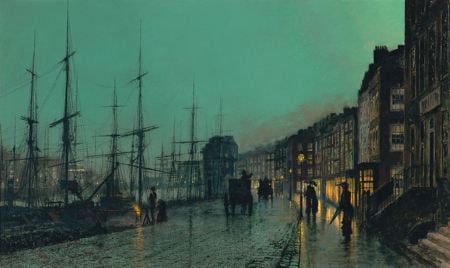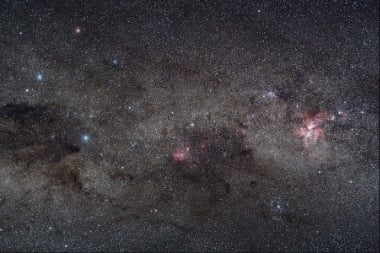Sonny’s Blues
Jean Redpath
Where Dreams are Found
A Carnival Evening
Henri Rousseau
http://en.wikipedia.org/wiki/File:Henri_Rousseau_-_A_Carnival_Evening.jpg
The song is about a young man who becomes an old man who never pursues his dreams because his mother needs him at home, sort of like Luke Skywalker’s uncle needs Luke about the farm. Later in the song we are told:
Sonny’s dreams can’t be real, they’re just stories he’s read
They’re just stars in his eyes, they’re just dreams in his head
And he’s hungry inside for the wide world outside
And I know I can’t hold him though I’ve tried and I’ve tried
The lyric tells us that Sonny’s dreams can’t be real because they are just stories, stories from books, stories he’s been told, or stories from films, television, and songs that are just made up. The school where I teach is reconsidering its curriculum. We are told on the one hand that the new standards require students to do more with non-fiction and real life type “stuff.” Fiction, of course, is all made up and therefore it can’t be real and cannot really tell us much about life and how it is lived, or so some would suggest to us. Of course it should be remembered that there is a great deal of non-fiction that, if read correctly, is going to be read for more than just the information it provides, that is a body of literature as worthy of study as any important work of fiction, but I fear non-fiction of this variety is seen to be as irrelevant to the school curriculum as the fiction that is being replaced.
They tell us that for the study of literature to have value it must provide students the opportunity to search and to find information. There is no point, for example, to studying Macbeth (or perhaps Edmund Burke or John Locke) if this study does not result in students learning facts they did not previously know; facts that will be useful to them in the future. The future, it seems, is all about gathering information and finding proper uses for it. I think Macbeth has much to teach us, but I do not know if there are many useful facts to be found.
The painting is of a clown and a woman standing under a cloudy, starlit sky. The title tells us it is a painting of a “carnival evening.” I am not sure what an evening must possess in order for it to be a carnival, but the painting captures whatever that something is. There was an article in the New York Times, “The Children’s Authors Who Broke the Rules”, about Maurice Sendak and other writers of children’s stories that did not play by the rules, whatever the rules are. There is much that is dreamlike, especially in Sendak, in the stories that these and other writers of children’s books tell. C. S. Lewis said of his Narnia books that they began with a dream he had of a faun standing by a lamppost in the middle of a snowy wood. On one level there is, of course, nothing real in a dream. On another, though, the stuff of dreams is immensely important and it silhouettes some of the deeper realities of our lives, realities that are perhaps too difficult to face in a more realistic setting.
Even if we do not believe what the likes of Jung and Freud tell us about dreams, the literature of the world, both sacred and profane, gives great significance to dreams. Malory’s Le Morte d’Arthur is packed with allegorical dreams. I particularly enjoy all the dreams that the various knights seeking the Holy Grail have. They are dreams that contain important information, life and death information, and there is always someone, usually a monk or hermit of some kind, who can tell the knight what the dream means. On at least one occasion the interpreter of the dream is a fraud whose interpretation of the dream is also a fraud. Dreams being what they are, it is not difficult to spin them in a number of different ways, not all of which are enlightening. There is a message here as well; that it is not enough to dream, but it is also important to understand our dreams correctly.
Nightfall down the Thames
John Atkinson Grimshaw
http://en.wikipedia.org/wiki/File:Grimshaw-NightfallThames.jpg
But what has all this to do with curriculum standards and the usefulness of fiction? Aristotle thought that poetry, and by poetry we soon realize he means story telling, has value because, unlike history, it does not tell us what has happened, but what might be. Aristotle also thought that stories show us how a philosophy of life might be lived out. They answer (or suggest answers) to questions like: What are the implications of our philosophy for our futures? How do our beliefs guide our choices? What does our philosophy teach us? The problem with non-fiction, or much of it and certainly the kind of non-fiction the proponents of the new standards seem to have in mind, is that it just presents information that we can accumulate, it does not make us wise, it does not teach us what to do with the information once we acquire it. The paintings above and below are of seaports, one on the River Thames and one on the River Clyde. This is suggestive because these seaports are not on the sea but on rivers that lead to the sea. What is important is not where we are, but where we can get to from where we are. What is important in what we read is not the information that is conveyed, but where that information can take us. A manual that shows us how to properly set up and configure our computers tells us nothing about why we would want or need to set up and configure that computer in the first place.
Shipping on the Clyde
John Atkinson Grimshaw
http://en.wikipedia.org/wiki/File:Shipping_on_the_Clyde.jpg
Both of the seaports are shrouded in mist. This mist limits our vision, we cannot see as far in a fog as we can when the horizons are clear and sunlit. To read for information only, without a clear idea as to what the value of the information is, or to even care if it has value, is to read in a fog and at the end of the day all we will have is information without an imagination adequate enough to put that information to good use, or to pass judgment on it and discard it when it has no use or is, worse yet, deceptive or unhealthy. I was told when I was in school that medieval scholars believed everything they read in books, even when what they read in different books was contradictory. This was both a strength and a weakness; a strength because it prodded them to seek synthesis, to find a way to bring these contradictory ideas together to reveal a hopefully deeper truth. A weakness because it produced a kind of naiveté that gave greater value to some of what they read than was warranted or even wise. There is something of this medieval view in the attitude we are being encouraged to take towards non-fiction. It is what justifies the teaching of informational texts in place of literature. But reading for information only is not reading critically, it is premised on the belief that what is written in books must be true and therefore can be trusted.
I am sure that I am oversimplifying the new curriculum standard and the way it is being presented, but one of the things that reading literature does, if we read deeply and well, is to make judgments about characters and ideas and the implications of the actions of the characters in the stories. When we read books like The Catcher in the Rye or The Turn of the Screw we must evaluate the narrators and the validity of the stories they are telling us. For even if these narrators truly believe the stories that they tell and believe they are telling us what happened as it truly happened, we see throughout their narratives that they are not reliable witnesses. In many ways they are the most convincing witnesses against the truth of the story they tell. We in our lives will encounter every day people who will tell us stories that cannot be true, even though on occasion the people telling the stories may honestly believe in the truth of the tale they tell.
When we read fiction well we are learning from experience, from experiences we are having with other people who, even if they are fictional, are forcing us to make judgments about what they say and do and we avoid these judgments to our peril. If we read the books mentioned above for information alone all we know at the end of the story is that Holden Caulfield had a harrowing few days in New York City and a child died in a governess’ arms. What we do not know is whether the most harrowing events are taking place in the city or in the mind of the young narrator or if the governess is the child’s protector or his killer.
Château Noir
Paul Cezanne
http://en.wikipedia.org/wiki/File:Paul_Cézanne_026.jpg
There is another value to reading fiction and that relates to Aristotle’s first point about the value of stories; that they show us what might be. They stimulate the imagination. Neal Stephenson in an article in the World Policy Journal, “Innovation Starvation”, suggests that many of the advancements in science and technology that took place in the 1950’s and 1960’s had their origins in science fiction novels that speculated about the future. And even where the predictions in these novels did not come to pass, they still stimulated the imagination. Stephenson talks about waking up early to watch the old Gemini mission launches. I remember waking up to watch not only the Gemini launches, but the Mercury launches as well and like Stephenson I followed the space program from its glorious beginnings to its more mundane ending. It seems to me that as our cultural imagination went into decline so did our cultural ambitions. We exchanged a dream of visiting other planets and solar systems for a fleet of celestial cargo ships. When the imagination necessary to pursue the dream declined and vanished, the dream died. It is not necessary that the new dreams that replace the old involve space travel, but they do need to involve something large, something that inspires and rekindles our enthusiasm for accomplishing the sublime.
What We Learned from 5 Million Books
TED Talks
The video is not just about collecting books digitally so that they will always be with us, but about the power of language and the value of preserving that language. Aiden and Michel in their presentation point out that much has been lost and is unrecoverable from antiquity. It may be that much, even most, of what has been lost has been lost for good reason. But we cannot know that for sure. There was a review of a new book by Stephen Greenblatt, The Swerve, in the Guardian, “The Swerve: How the Renaissance Began by Stephen Greenblatt – review”. The book tells the story of the re-discovery of Lucretius’ book On the Nature of Things, a book that had been lost for many centuries and existed only as oblique references in the work of other ancient authors. The name of Lucretius was known as was the name of the book, but the book itself was lost. This book that was lost and was found went on to inspire many Renaissance writers, thinkers, and scientists. The Guardian is of the opinion that Greenblatt’s claims may be a bit exaggerated, but it recognizes the value of the book itself.
In another review in the New York Times, “The Almost-Lost Poem That Changed the World” (which you must be a subscriber to the New York Times to read) Greenblatt is quoted saying, “I am constantly struck,” Greenblatt told The Harvard Gazette in 2000, when he was named a university professor, “by the strangeness of reading works that seem addressed, personally and intimately, to me, and yet were written by people who crumbled to dust long ago.” And this is at the heart of why we read literature. Books are letters of a sort, a kind of correspondence where we communicate with those long dead because the content of the conversation will always have relevance if we take the time to understand what is being said to us. Maimonides, St. Paul, Confucius, Homer, Scheherazade, and all the other writers long dead who continue to inspire the living and, if given the opportunity, many generations to come, desire to chat (and I use this word not to be flippant but to suggest the intensely personal nature of the conversation) with us. Like Socrates in the Agora they engage us with questions about life and how it is lived and what gives it meaning.
And even if we do not agree with their conclusions there is value in letting them help us shape our own conclusions, if only by accepting the challenge to think as deeply about things as they have thought, so that our conclusions, though different, will be as acutely considered. Or as Sarah Bakewell, quoting Petrarch, pointed out later in her New York Times review of the Greenblatt book, “Gold, silver, jewels, purple garments, houses built of marble, groomed estates, pious paintings, caparisoned steeds and other things of this kind offer a mutable and superficial pleasure; books give delight to the very marrow of one’s bones. They speak to us, consult with us and join with us in a living and intense intimacy.” I wonder if a book can have an impact this profound if it is read solely for information, or what is worse, if the only books we read are those that provide information to be gleaned without inspiring the reader to do much of substance with what’s been found.
Red Tree
Piet Mondrian
http://www.artchive.com/artchive/M/mondrian/mondrian_red_tree.jpg.html









